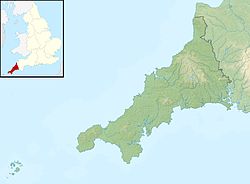Cornwall and West Devon Mining Landscape
| UNESCO World Heritage Site | |
|---|---|
 Part of Crown Mines, Botallack (St Just Mining District) | |
| Location | Cornwall and West Devon, United Kingdom |
| Criteria | Cultural: (ii), (iii), (iv) |
| Reference | 1215 |
| Inscription | 2006 (30th Session) |
| Area | 19,719 ha (48,730 acres) |
| Coordinates | 50°8′10″N 05°23′1″W / 50.13611°N 5.38361°W |
The Cornwall and West Devon Mining Landscape is a World Heritage site. It includes select mining landscapes in Cornwall and West Devon. The site was added to the on July 2006. Plans to restart mining at South Crofty,[1] and to build a supermarket at Hayle Harbour,[2] caused its status to be questioned.
The World Heritage Committee considered placing the site on the List of World Heritage in Danger in 2014. This proposal was rejected. Instead, they agreed on a follow-up "Reactive Monitoring Mission".[3][4]
History
[change | change source]Devon made around 25-40% of the amount of tin that Cornwall did up to the mid-16th century. However, the total amount of tin made in both Cornwall and Devon at this time was relatively small. After the 1540s, Cornwall's production took off while Devon's production was only about between a ninth to a tenth of that of Cornwall.
From the mid-16th century onwards, the Devon Stannaries were giving very little in income to the King. They were sidelined after the Supremacy of Parliament Act 1512.
The landscapes of Cornwall and West Devon were reshaped during the 18th and 19th centuries by the mining of copper and tin. The underground mines, engine houses, foundries, new towns, smallholdings, ports, harbours, and other supporting industries together meant the region produced two-thirds of the world's supply of copper.
During the late 19th century, arsenic production came to the east of Cornwall and West Devon. As a result, the region supplied half the world’s demand. [5]

Areas
[change | change source]
The World Heritage site consists of individual but topical linked areas around Cornwall and West Devon. The areas (with the area codes from the site nomination) are:[6]
- A1 - St Just Mining District
- A2 - Port of Hayle
- A3i - Tregonning and Gwinear Mining District
- A3ii - Trewavas
- A4 - Wendron Mining District
- A5i - Camborne and Redruth Mining District
- A5ii - Wheal Peevor
- A5iii - Portreath Harbour
- A6i - Gwennap Mining District
- A6ii - Devoran and Perran Foundry
- A6iii - Kennall Vale
- A7 - St Agnes Mining District
- A8i - Luxulyan Valley
- A8ii - Charlestown
- A9 - Caradon Mining District
- A10i - Tamar Valley
- A10ii - Tavistock
Ancient rocks, rare heavy elements
[change | change source]
Devon and Cornwall rocks were once in the core of huge volcanic mountains. Those rocks usually contain more heavy metallic elements than usually found on the Earth's surface. A recent news item says a new mineral was found in Cornwall called Kernowite.[7]
Rocks from ocean floor mid-ocean ridges (oceanic lithosphere) may come to the surface under orogeny as ophiolites. Wherever there is a large ground-down mountain chain there may be a source of heavy metals.
Related pages
[change | change source]References
[change | change source]- ↑ Cornwall News (8 November 2012). "Unseco threaten to pull South Crofty mining 'world heritage status' if mining starts". falmouthpacket.co.uk.
- ↑ Simon Parker (21 June 2013). "UN threat to Devon and Cornwall's heritage site status". westernmorningnews.co.uk. Archived from the original on 9 August 2014. Retrieved 27 July 2014.
- ↑ "Decisions Adopted (38th Session 2014)" (PDF). UNESCO World Heritage. UNESCO World Heritage Centre. Retrieved 16 October 2014.
- ↑ "Cornwall and West Devon Mining Landscape Current conservation issues 2014". unesco.org.
- ↑ "Ten things you probably didn't know about Cornish mining". National Trust. Retrieved 2020-08-13.
- ↑ "The World Heritage Site Areas". Cornwall & Scilly Historic Environment Service. 2006. Archived from the original on 26 April 2007. Retrieved 25 May 2007.
- ↑ Kernowite: New mineral found on rock mined in Cornwall. BBC News. [1]
Other websites
[change | change source]- UNESCO listing
- BBC – World Heritage site bid gets go-ahead
- Cornish Mining - World Heritage StatusArchived 2012-04-19 at the Wayback Machine



